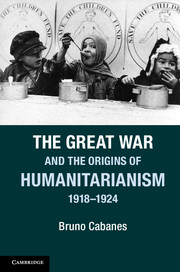Book contents
- Frontmatter
- Contents
- Acknowledgments
- Introduction Human disasters: humanitarianism and the transnational turn in the wake of World War I
- 1 “Rights, not charity”: René Cassin and war victims
- 2 Justice and peace: Albert Thomas, the International Labor Organization, and the dream of a transnational politics of social rights
- 3 The tragedy of being stateless: Fridtjof Nansen and the rights of refugees
- 4 The hungry and the sick: Herbert Hoover, the Russian famine, and the professionalization of humanitarian aid
- 5 Humanitarianism old and new: Eglantyne Jebb and children's rights
- Conclusion Human dignity: from humanitarian rights to human rights
- Further reading
- Bibliography
- Index
- References
4 - The hungry and the sick: Herbert Hoover, the Russian famine, and the professionalization of humanitarian aid
Published online by Cambridge University Press: 05 June 2014
- Frontmatter
- Contents
- Acknowledgments
- Introduction Human disasters: humanitarianism and the transnational turn in the wake of World War I
- 1 “Rights, not charity”: René Cassin and war victims
- 2 Justice and peace: Albert Thomas, the International Labor Organization, and the dream of a transnational politics of social rights
- 3 The tragedy of being stateless: Fridtjof Nansen and the rights of refugees
- 4 The hungry and the sick: Herbert Hoover, the Russian famine, and the professionalization of humanitarian aid
- 5 Humanitarianism old and new: Eglantyne Jebb and children's rights
- Conclusion Human dignity: from humanitarian rights to human rights
- Further reading
- Bibliography
- Index
- References
Summary
“It was our privilege to forfend infinite suffering from these millions of people, to save millions of lives, and it was our opportunity to demonstrate America's ability to do it in a large, generous and efficient way, befitting our country.”
Herbert Hoover, “America's obligations in Belgian relief.”In the summer of 1921, news of one of the worst famines in Russian history began to reach Europe and the United States. For months the Volga valley—Russia's breadbasket—had not received a drop of rain. The agricultural crisis spread progressively, extending into southern Ukraine, the Transcaucasus, and the Urals. Starvation threatened more than 25 million people. In the villages, the oldest inhabitants remembered the famine of 1891–92, which had caused some 375,000 to 400,000 deaths. Many thought that this time the situation was worse. “An unprecedented calamity, such perhaps as we have not seen since the days of Czar Alexis,” lamented the writer Vladimir Korolenko, aged 68, referring to the great agrarian crises of the mid seventeenth century.
- Type
- Chapter
- Information
- The Great War and the Origins of Humanitarianism, 1918–1924 , pp. 189 - 247Publisher: Cambridge University PressPrint publication year: 2014
References
- 1
- Cited by



